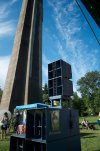On subs, you can get very small - producers and consumer listeners will sometimes use the SubPac or similar brands. It straps on, has batteries and has a wired or wireless program feed. You also see the same in gamer chair tactile pads.
A friend of mine is deaf. He has a project to translate music to other senses, light and tactile. The SubPac company has been very generous in supporting projects like that. The transducer is small and battery powered, but ideal for one person to feel bass.
The other thing you see is the DBX patented subsonic synthesizer in pro gear. A producer can use it in the studio to add bass, or a pro sound installation which needs bass for EDM can use it. There are competing implementation plugins for audio production software. They are sometimes used on the bass drum in tracking. It is certainly not a linear item we usually discuss, but in recording many deliberate nonlinear effects are used.
https://dbxpro.com/en/product_families/subharmonic-synthesis
A friend built a large and heavy outdoor dance sub with a linear actuator, but I don't know what the piston was attached to. I believe it was this. The main expense was renting a storage space and trucks to move it.


